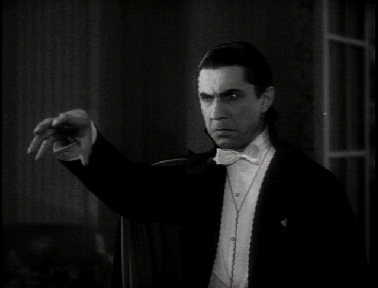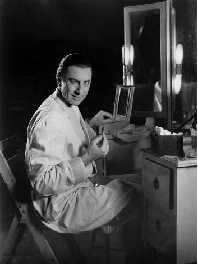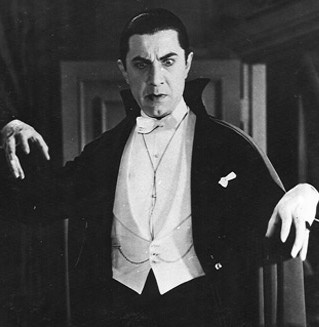|
The man who will always be known as Dracula actually had a long and distinguished acting career (mostly on stage) before donning cape and fangs in Hollywood. In 1901, after studying at the Budapest Academy of Theatrical Arts, this banker's son made his stage debut as a featured juvenile. Tall, aristocratic, and handsome in a vaguely sinister way (with piercing eyes and a cruel mouth), he spent the next two decades building a reputation as one of Hungary's great matinee idols, and made his first film-A Leopard-in 1917. Political turmoil in his homeland drove Lugosi to Germany in 1919; he appeared in several films there, including a 1920 adaptation of Dr. Jekyll and Mr. Hyde and a 1922 filmization of The Last of the Mohicans.
Emigrating to America shortly thereafter, Lugosi toiled in stage melodramas and routine programmers (such as 1923's The Silent Command and 1925's The Midnight Girl) before assuming the title role in the 1927 Broadway production of "Dracula," which he also essayed for two years on the road. The thick, almost impenetrable accent that hampered him in most roles actually proved to be an asset when he played Bram Stoker's Transylvanian vampire. Film rights to the play were sold to Universal, which announced that Lon Chaney would play the title role. But Chaney's untimely death from cancer in 1930 prompted producer-director Tod Browning to cast Lugosi instead. Dracula (1931) launched Universal's long-running cycle of horror movies and made its star a household name overnight.
Unfortunately, the movie's success also doomed Lugosi to a lifetime of boogeyman roles in vehicles of steadily diminishing quality. After refusing to play the Monster in Frankenstein (1931, the role taken by Boris Karloff), he played his first mad doctor in Murders in the Rue Morgue a voodoo master in White Zombie (delivering a wonderfully florid, over-thetop performance), and a priest of the Black Arts in Chandu the Magician in 1932 alone. But the next year he was already working for Poverty Row producers, getting top billing in Mascot's The Whispering Shadow and Majestic's The Death Kiss but winning only supporting roles in major-studio productions such as The Island of Lost Souls and International House (all 1933). Independent producer Sol Lesser gave Lugosi a bona fide hero role as the star of The Return of Chandu a 1934 serial also released in featurelength version. That same year he returned to Universal for The Black Cat (1934), the first (and best) of several chillers that teamed him with Karloff, whose career eclipsed Lugosi's almost from the start.
Lugosi's typecasting and his failure to master the nuances of the English language certainly hampered his American film career, but he also proved to be his own worst enemy, taking leads in the most abysmal mini-budget schlockers for whatever money producers were willing to pay. A colorful character role, that of Ygor, the mad shepherd in Son of Frankenstein (1939), briefly restored Lugosi to prominence, and he appeared to good advantage in that year's Ninotchka (starring Greta Garbo), but he alternated strong supporting roles in Universal's Black Friday (1940), The Wolf Man (1941), and The Ghost of Frankenstein (1942, again as Ygor) with negligible turns in low-budget Monogram melodramas produced by schlockmeister Sam Katzman, who teamed Lugosi most ignobly with the East Side Kids in Spooks Run Wild (1941) and Ghosts on the Loose (1942).
In 1943 Lugosi, by this time in no position to be choosy about his roles, agreed to play the Frankenstein monster-a part he had previously eschewed on the grounds it offered him no dialogue and would submerge him beneath heavy makeup-in Frankenstein Meets the Wolf Man He played a Dracula-like character in The Return of the Vampire that same year, and made the most of a small role (again opposite Karloff) in Val Lewton's literate, effective version of The Body Snatcher (1945). Lugosi then plunged into the depths of Poverty Row hell, a descent checked only briefly with his wonderfully deadpan turn as Dracula in Abbott and Costello Meet Frankenstein (1948), the last good picture he made. By the 1950s the pickings were slimmer than ever; he submitted to demeaning personal appearance tours, and even starred in a selfnamed comedy-chiller, Bela Lugosi Meets a Brooklyn Gorilla (1952). An addiction to morphine finally got the best of him and in 1955 he checked himself into a rehab hospital for treatment. His last screen appearance was undertaken for fanproducer Edward D. Wood in Plan 9 From Outer Space (filmed 1956 but released 1959); he died during production and his scenes were completed by a stand-in. Lugosi was buried in the cape he always wore as Dracula. He was portrayed by Martin Landau in Ed Wood (1994).
Contrary to popular belief, he and Boris Karloff did not hate each other, as the famous scene from Ed Wood (1994) would lead one to believe. Both men's children have said that the only rivalry that existed between them is when they were both up for the same parts, and in reality, Lugosi and Karloff had almost no relationship off-set.
OTHER FILMS INCLUDE: 1929: The Thirteenth Chair 1931: The Black Camel 1933: Night of Terror, The Devil's in Love 1934: The Gift of Gab (cameo with Karloff); 1935: The Mysterious Mr. Wong, Murder by Television, Mark of the Vampire, The Raven (with Karloff, playing a Poe-inspired surgeon); 1936: The Invisible Ray (again with Karloff), Shadow of Chinatown 1937: S.O.S. Coast Guard 1939: Dark Eyes of London (aka The Human Monster), The Phantom Creeps 1940: You'll Find Out (with Karloff and Peter Lorre); 1941: The Devil Bat, The Invisible Ghost 1942: Black Dragons, The Corpse Vanishes, Bowery at Midnight 1943: The Ape Man 1944: Voodoo Man, Return of the Ape Man, One Body Too Many 1945: Zombies on Broadway 1946: Genius at Work 1947: Scared to Death 1952: Old Mother Riley Meets the Vampire 1953: Glen or Glenda? (his first for Ed Wood); 1955: Bride of the Monster 1956: The Black Sleep.
|
|


